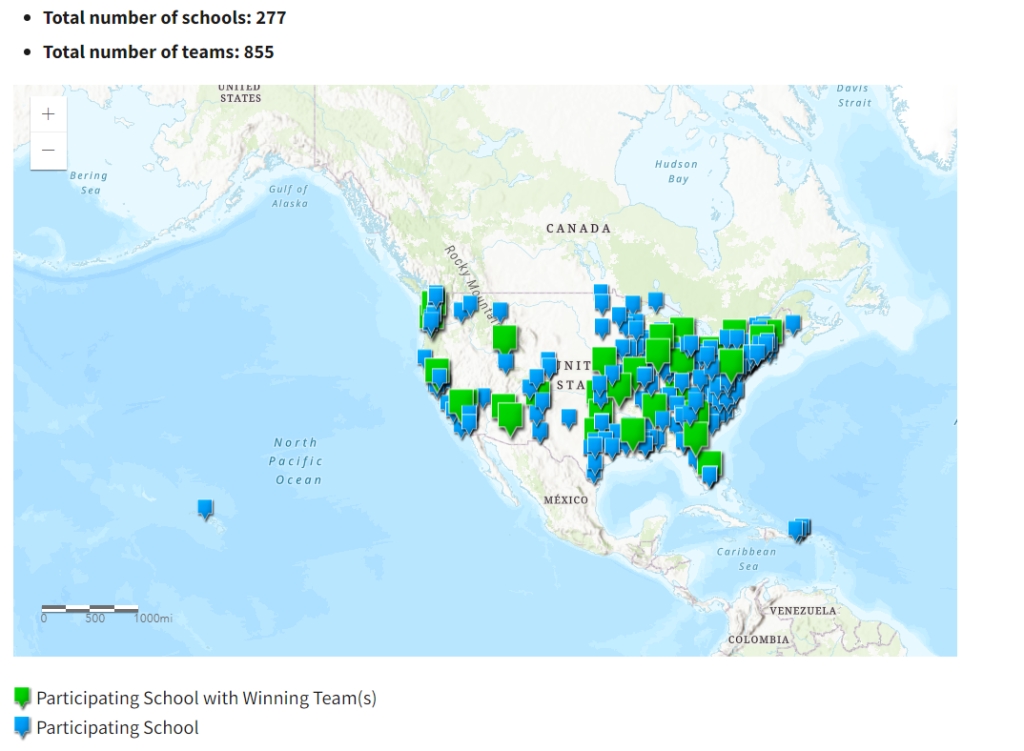On September 18, the U.S. Environmental Protection Agency (EPA) announced student teams from the University of Oregon (Eugene) and Hobart and William Smith Colleges (HWS; Geneva, New York) as winners of its 11th Campus RainWorks Challenge.
The annual Campus RainWorks Challenge, returning from a 1-year hiatus, celebrates efforts by students at U.S. colleges and universities to demonstrate how green infrastructure can address flooding and protect water quality, all while improving quality of life for the surrounding community. Students work in teams to develop far-reaching plans for green infrastructure implementation at their campus or a nearby school, collaborating closely with groundskeeping staff as well as the locals who will benefit from the proposed plans.

Previously, Campus RainWorks Challenge teams vied for the top spot in one of two categories: Demonstration Project, proposing singular installations; and Master Plan, developing broader implementation strategies over larger areas. This year, for the first time in challenge history, EPA judged entries from the 13 participating teams according to consistent criteria and chose two overall winners.
The Water Environment Federation (Alexandria, Virginia) has provided judging and outreach support for the Campus RainWorks Challenge since the program’s introduction in 2012, joined by the American Society of Civil Engineers (Reston, Virginia) and the American Society of Landscape Architects (Washington, D.C.). This year’s cohort brings the total number of teams to participate in the Campus RainWorks Challenge to 855, encompassing 277 institutions.
“Stormwater runoff is one of the biggest sources of pollution affecting our waterways, and EPA’s Campus RainWorks program inspires students to assess local challenges and develop creative and comprehensive solutions using green infrastructure,” said Bruno Pigott, Acting EPA Assistant Administrator for Water, in a release. “Congratulations to this year’s winners and to all of the participants who developed innovative solutions to protect the environment and support stronger communities.”
Reusing Roof Runoff as a Resource
The team representing the University of Oregon endeavored to use runoff generated at a local K-8 school as a resource, not only mitigating flooding but also providing new play amenities for students.
A key element of the project, which proposes a redesign of the flood-prone play yard at the Village School in Eugene, involves redirecting freshly fallen rain from the school’s 650-m2 (7,000-ft2) rooftop through a system of new drains, vegetated ditches, and gardens in a way that promotes intentional ponding. This creates a water-centric playground that puts runoff to productive use, featuring safe areas for students to recreate in swales and infiltration areas. Other elements of the design include rain gardens, play areas equipped with 158 m2 (1,700 ft2) of permeable materials, and a small, on-campus forest, as well as a new network of accessible ramps and bridges to improve campus connectivity and circulation.
Judges lauded the University of Oregon team for their extensive outreach with the Village School community, working with staff and students to identify desires and design priorities. For example, the team surveyed a panel of 35 fifth grade students about the improvements they would like to see in their redesigned schoolyard and ensured these preferences were met. Among notable results, 49% of polled students indicated hopes for better-maintained grass and turf areas and 40% called for a new pond or pool.
“When we started this project, we were really interested in centering the children as the main focus for the design,” said team member Katherine Rola, a University of Oregon graduate student studying planning, public policy, and management, in a video about the proposal. “Our question was, ‘How can we make changes to this space so that it’s multifunctional, [can] provide children with opportunities to play, and have opportunities for education while also managing stormwater?’”
The proposed design for the entire campus represents significant improvements for stormwater management, reducing peak runoff generation by up to 0.02 m3/s (0.64 ft3/s) while delaying peak flow rates by approximately 20 minutes. According to the team’s modeling efforts, this equates to a potential reduction of up to 75% in peak runoff volumes campuswide during intense rainfall events. Finally, the proposal includes a plan to help offset the approximately USD $640,000 capital expenses of the project using existing state and federal grant programs.
Get full details about the University of Oregon team’s winning proposal.
Balancing Human and Environmental Needs
Although the two HWS campuses that straddle the shores of Seneca Lake in the Finger Lakes region of New York are only minutes apart, poor pedestrian connectivity often forces students to travel to and from different classes via vehicle. At the same time, the region experiences approximately 86 cm (34 in.) of rain each year, with precipitation volumes expected to skyrocket in coming decades. This often breaks the banks of Odell Pond, a landmark of the main HWS campus, and causes localized flooding in densely populated student centers.
The HWS team’s proposal describes “Project Pond Walk” as an ambitious campaign to transform community walkability as well as alleviate stormwater-related burdens on Odell Pond and its surroundings.
Project Pond Walk calls for a new system of permeable walking-and-biking paths that align with the area’s central drainage route, marked by new bike-sharing stations, sidewalks, and crosswalks. The design capitalizes on a recently acquired stretch of woodland to link a system of four existing retention ponds as well as pedestrian transmission between the two campuses. Around the pedestrian network as well as Odell’s Pond, the proposal features a range of bioswales, rain gardens, and native plants, supplemented by educational signage that teaches passersby about the region’s cultural history and ecological challenges. It additionally prescribes new amenities on currently underutilized space, including a community garden, tree nursery, and outdoor classroom.
The project team described Project Pond Walk as a way to build on HWS’ reputation for environmental sustainability.
“The colleges have a longstanding commitment to environmental stewardship,” one team member said during a video about the proposal. “HWS is a certified Bee Campus, Tree Campus, and in 2024, became one of 11 colleges and universities in the U.S. to achieve carbon neutrality. Project Pond Walk offers a bold continuation of this legacy.”
According to the team’s analysis, Project Pond Walk would reduce average travel time between the two HWS campuses by 50%, cut existing impervious surface coverage by 26%, and mitigate runoff generation by 16%. The project carries an estimated USD $9 million in capital costs as well as $220,000 in annual maintenance, with potential to offset some of these costs using state and federal grants.
Learn more about Project Pond Walk at Hobart and William Smith Colleges.
Top image courtesy of EPA

ABOUT THE AUTHOR
Justin Jacques is editor of Stormwater Report and a staff member of the Water Environment Federation (WEF). In addition to writing for WEF’s online publications, he also contributes to Water Environment & Technology magazine. Contact him at jjacques@wef.org.




